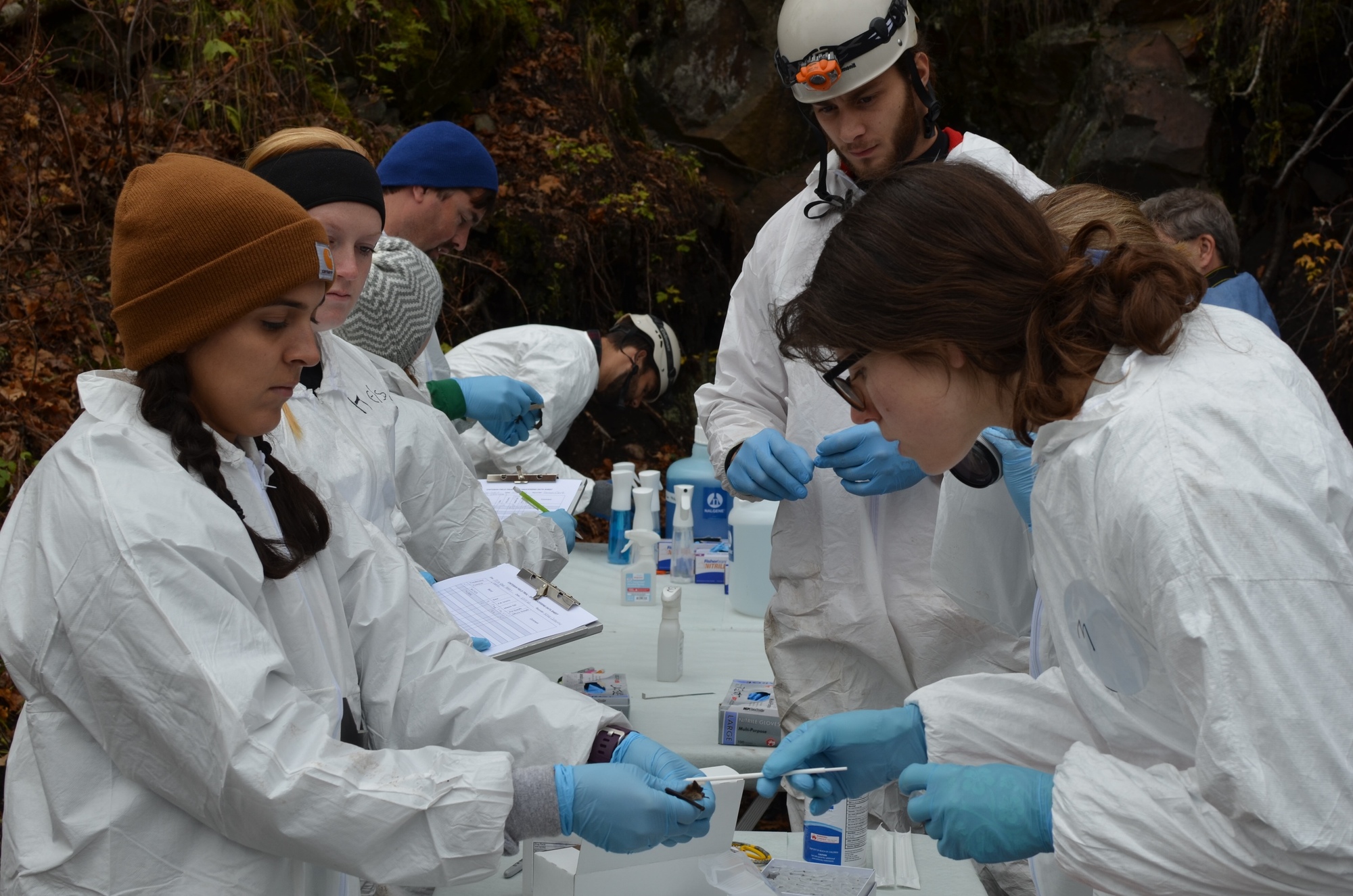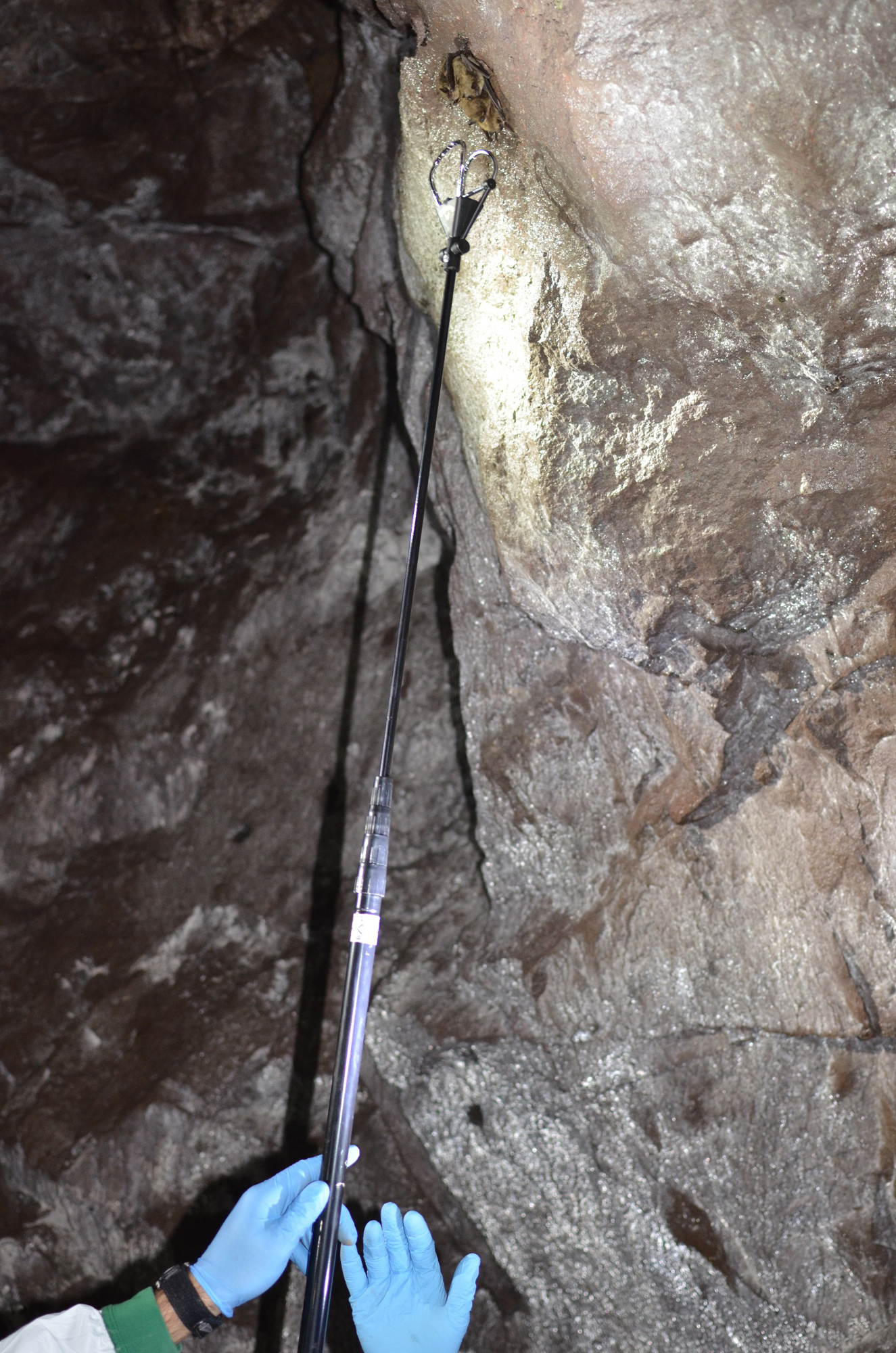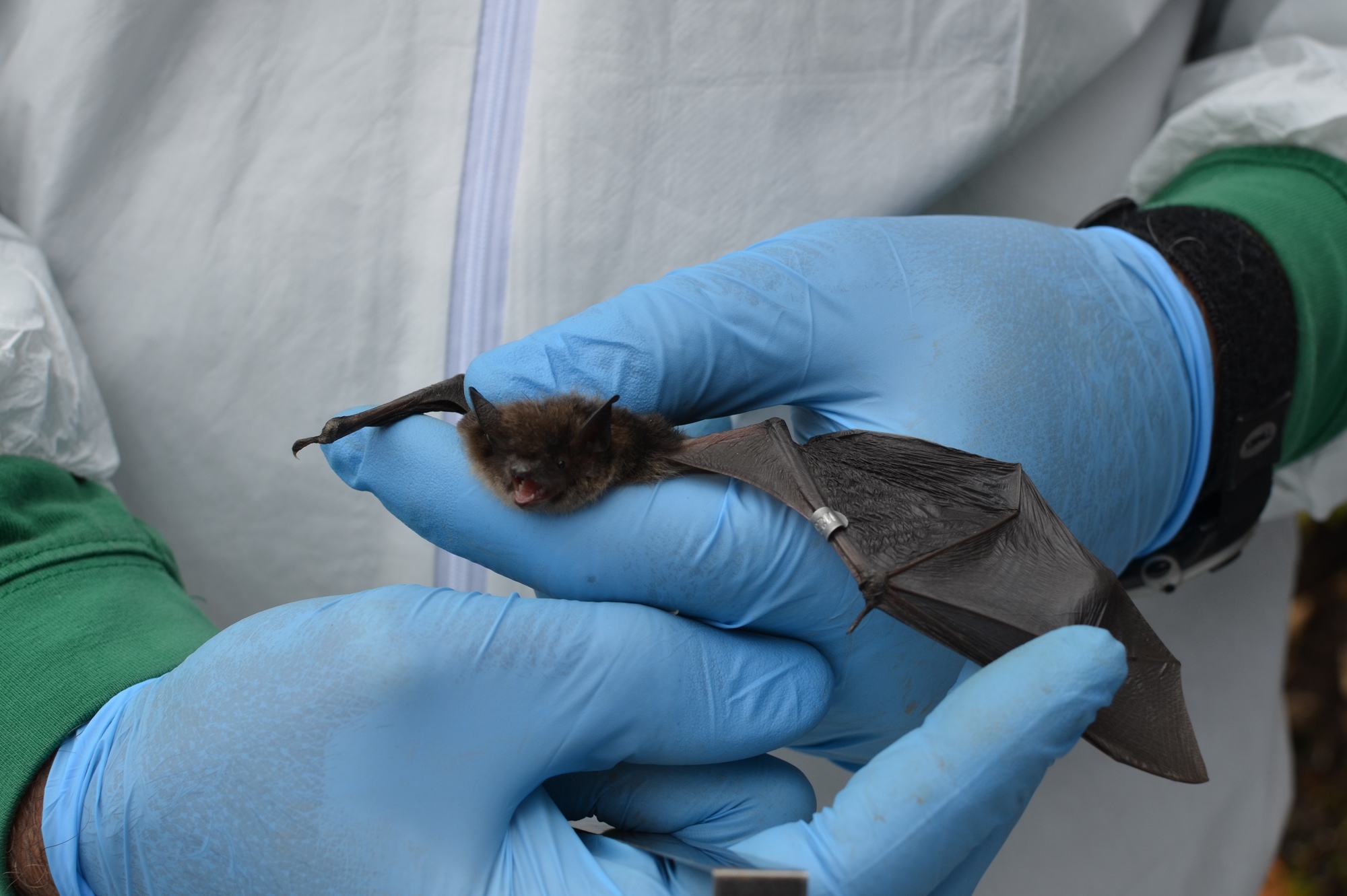DNR field testing treatments in U.P. for deadly bat disease
Groundbreaking research projects seek to protect Michigan’s bats
The scene was surreal – like something you’d see in a science fiction movie, particularly a B-movie creature feature.
Outside the entrance to a dark winding cave, at the foot of a steep, rocky, leaf-strewn bluff, a team of scientific researchers dressed in white, full-length protective suits, hard hats, rubber boots and gloves stood hunched over instruments laid out on steel tables.
The tables, placed end-to-end lengthwise, were covered with butcher paper. There were bottles of chemicals, paper bags pinched closed at the top, scales and – at the end of the tables, closest to the cave – a cylindrical wire mesh cage.
This was to be an assembly line type of operation. The team worked quickly, passing tiny, squeaking creatures hand-to-hand, from the far end table up toward the cage and the mouth of the cave – the bat cave.
The creepy unsettling thing living in this cold, damp abandoned mine was not the bats – it’s the insidious disease that’s killing them.
The malady is called white-nose syndrome – named for the pale-colored fungus found on the wings, noses, ears and tails of infected bats – and on this chilly October day in Ontonagon County, the biologists working outside the cave have high hopes of stopping it.
“White-nose syndrome is a devastating disease. It’s killed millions of bats in eastern North America already,” said Maartin Vonhoff, a professor of biological sciences at Western Michigan University. “And so, there’s been a huge effort by state and federal biologists, by academic biologists, to try and come up with treatments that will make a difference and save the lives of bats.”
Since 2006, researchers have confirmed white-nose syndrome in bats in more than two dozen states, including Michigan, in 2013, and neighboring Wisconsin, Minnesota, Indiana, Illinois, Ohio and Ontario.
Infected hibernating bats, awakened prematurely by the disease, may lose their reserves of fat needed for the winter. Some have been seen flying outside their caves in the middle of winter.
 With no insects available to feed on, and stored fat diminished, these bats die. With no insects available to feed on, and stored fat diminished, these bats die.
White-nose syndrome is not only fatal to little brown bats, but at least a half-dozen other species, including the U.P.’s big brown bats and northern long-eared bats.
Vonhoff was leading the team of biologists and university students outside the cave. He is part of a cooperative research project with Ball State University, taking place in two remote abandoned mines in the western Upper Peninsula.
The team is field testing a substance called chitosan, a type of fiber taken from the shells of crustaceans and insects that acts against the fungus (Psuedogymnoascus destructans) causing white-nose syndrome.
Chitosan had previously been tested on bats in a laboratory environment.
“It prevents the fungus from growing. It also has wound-healing capabilities so it speeds up the healing of wounds. And when bats get white-nose syndrome, the fungus grows across their skin and then it causes damage to that skin and the bats end up with holes in their wings,” Vonhoff said. “So, we’re hoping that chitosan will limit the growth of that fungus and will limit the extent of damage to the tissues of the bats and thereby increase their survival.”
A couple members of the team entered the abandoned mine, walking through standing water pooled over an old narrow gauge railroad track.
They encountered a number of bats clinging to the whitish-gray stone covering the walls and ceiling of the Firesteel adit (horizontal mine passageway) and its short passages. About 40 little brown bats and a lone northern long-eared bat were inside the mine. bat were inside the mine.
Though no snow was on the ground, and it was still a week or so before Halloween, the bats had begun to hibernate for winter in the mine.
With a count of the bats complete, team members captured the bats, removing them from the walls with gloved hands or by using a metal pole, gripping-type tool, which was extended to reach bats huddled together on the highest parts of the walls and ceiling.
Having put the bats collected individually into the small paper bags, they were taken outside the mine to the assembly line tables. Here, they were sexed, weighed and measured.
“We’re going to swab their skin to see whether they have the fungus on them that causes white-nose syndrome,” Vonhoff said. “And then we’re going to give them either the treatment of chitosan or we’re going to treat them with a, we call it a control solution, so it’s got everything in it except for the chitosan.”
Application of these substances will allow the researchers to test whether treatment of the bats has any impact on their survival.
“So we treat them, we’re going to put them back in the mine and then we’re going to come back in the spring and we’re going to see how many of them are alive,” Vonhoff said. “And the prediction would be that if chitosan works, that more chitosan-treated bats will have survived the winter come the spring than the control-treated bats.
“If it doesn’t work, then unfortunately, the bats will probably have died.”
Bill Scullon, a field operations manager from Michigan Department of Natural Resources' Norway office, said each bat was uniquely tagged and will be followed to see what benefits the treatments have in reducing mortality rates.
“Even modest reductions in the normally very high white-nose syndrome induced mortality rates can have significant positive implications of species recovery over the long term,” Scullon said.
 With the bats back in the mine, the research team sealed the entrance with metal mesh screen attached to a wooden frame. With the bats back in the mine, the research team sealed the entrance with metal mesh screen attached to a wooden frame.
This effort to help the state’s bat populations is one of several endeavors the Michigan DNR is involved in, which are taking place across the western U.P. mining country.
“The DNR’s Wildlife Division has a long history of being on the leading edge of bat conservation and research,” Scullon said. “This is more important than ever today in the battle to save our imperiled bat species from white-nose syndrome.”
A second treatment project applies a chemical agent to the inside of mines or caves, rather than the bats themselves, in hopes of killing the fungus present before bats return to hibernate.
For this project, the DNR has teamed up with Wisconsin DNR and the University of California Santa Cruz to treat two abandoned mines in the western U.P.
“Chlorine dioxide is used to kill all the fungal spores throughout an entire mine during the summer before bats return for the winter,” said Michigan Department of Natural Resources wildlife biologist John DePue of the Baraga office. “The theory is that this will clean the site and reduce infection rates and subsequent mortality below what would otherwise be expected.”
A licensed contractor applied the chlorine dioxide, which is approved by the U.S. Environmental Protection Agency and is commonly used in the food industry to clean food processing plants.
“The chlorine dioxide spray of ultra-fine droplets disperses throughout the crack and crevices within the mine micro-environment,” Scullon said. “Within 45 minutes, it breaks down to inert chemicals (salt and water) with no residual traces. However in the lab, it has proven highly effective in killing the fungal spores.”
Several sites were also treated this way in Wisconsin.
The DNR has also worked to gate the entrances to abandoned iron and copper mines and caves.
“These custom steel structures are designed to keep the public out and ensure public safety while allowing the bats to come and go,” DePue said. “They have been built on state, federal, and private lands. Some of these gated sites house populations of bats in excess of 50,000 in the winter.”
To further combat the human-assisted spread of white-nose syndrome by preventing people from tracking the fungal spores throughout Michigan and other areas of the continent that are free of the disease, the DNR recently placed three gates on U.P. mines.
 These three locations were sites where active white-nose syndrome bat treatment research is ongoing. These three locations were sites where active white-nose syndrome bat treatment research is ongoing.
Get more information on white-nose syndrome. Check out a DNR video on the ongoing U.P. bat research projects.
Catch upcoming stories by subscribing to free, weekly “Showcasing the DNR” articles. Check out previous Showcasing articles.
/Note to editors: Contact: Bill Scullon, 906-563-9247 or John Pepin 906-226-1352. Accompanying photos are available below for download and media use. Suggested captions follow. Credit: Michigan Department of Natural Resources, unless otherwise noted.
Band: A little brown bat sports an identification band which will help researchers track its movements.
Bats: Two little brown bats huddled together on the wall of a mine in Ontonagon County.
Flying: Little brown bats flying inside a mine in Dickinson County, which was gated, allowing the bats to come and go, but keeping humans out.
Fog: Chlorine dioxide fog, shown here in a Dickinson County mine, is used to kill fungal spores throughout a mine during the summer, before bats return for winter hibernation.
Gating: Workers are nearly complete in their installation of this bat gate across the mouth of a mine in Dickinson County.
Line: Researchers move a little brown bat down their assembly line in Ontonagon County.
Reach: A researcher reaches for a little brown bat on the wall of a cave in Ontonagon County.
Treatment: A little brown bat is treated during field tests ongoing in Ontonagon County./
The Michigan Department of Natural Resources is committed to the conservation, protection, management, use and enjoyment of the state’s natural and cultural resources for current and future generations. For more information, go to www.michigan.gov/dnr.
|


 With no insects available to feed on, and stored fat diminished, these bats die.
With no insects available to feed on, and stored fat diminished, these bats die. bat were inside the mine.
bat were inside the mine. With the bats back in the mine, the research team sealed the entrance with metal mesh screen attached to a wooden frame.
With the bats back in the mine, the research team sealed the entrance with metal mesh screen attached to a wooden frame.






